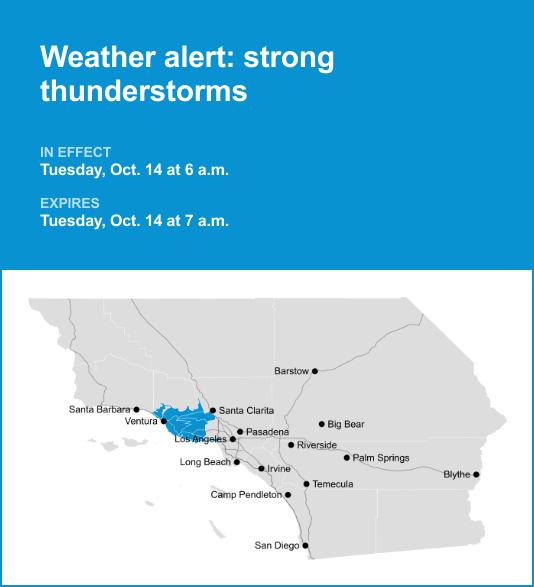Los Angeles County is included in an updated report for strong thunderstorms by the National Weather Service on Tuesday at 6 a.m. The alert is in effect until 7 a.m.
Residents may experience wind gusts of up to 50 mph.
“At 6 a.m., Doppler radar tracked a strong thunderstorm 8 miles north of Anacapa Island, or 9 miles northeast of Scorpion Ranch, moving east at 20 mph,” the NWS Los Angeles/Oxnard CA said. “Gusty winds could knock down tree limbs and blow around unsecured objects.”
Locations impacted by the alert include Oxnard, Thousand Oaks, Simi Valley, Ventura, Camarillo, Malibu, Agoura Hills, Moorpark, Santa Paula, Port Hueneme, Point Mugu State Park, Ventura Harbor, Newbury Park, Westlake Village, Point Dume, Oak Park, Solimar Beach, Naval Base Ventura County, Silver Strand Beach and Somis.
The NWS said, “If outdoors, consider seeking shelter inside a building. A Severe Thunderstorm Watch remains in effect until 9 a.m. for southwestern California.”
The full list of affected locations includes:
- Malibu
- Western Santa Monica Mountains Recreational area
- Calabasas/Agoura Hills
- Santa Susana Mountains
- Ventura County Beaches
- Ventura County Inland Coast
- Lake Casitas
- Central Ventura County Valleys
- Southeastern Ventura County Valleys

Preparing for approaching lightning: Expert safety advice
Lightning strikes the United States approximately 25 million times each year, mostly during the summer. Lightning claims the lives of about 20 people annually, according to the NWS. The risk of lightning-related incidents escalates as thunderstorms draw near, reaching its peak when the storm directly looms overhead. However, it gradually recedes as the tempest moves
To ensure your safety during a thunderstorm, consider the following recommendations:
Lightning safety plan:
- When venturing outdoors, it’s crucial to have a lightning safety plan in place.
- Stay vigilant by monitoring the sky for ominous signs and listening for the telltale sound of thunder. If thunder is audible, it’s a clear indication of nearby lightning.
- Seek a safe place to shelter, preferably indoors.
Indoors safety measures:
- Once you’ve found shelter indoors, abstain from using corded phones, electrical appliances, or plumbing fixtures, and refrain from approaching windows and doors.
- Lightning can follow conductive pathways, and these precautions reduce the risk of electrical surges.
Wait for the all-clear:
- After the last lightning strike or thunderclap, wait at least 30 minutes before resuming outdoor activities.
- It’s important to remember that lightning can strike even when a storm seems to have passed, so exercise caution.
When indoor shelter isn’t available:
If you find yourself outdoors without access to indoor shelter during a thunderstorm, take these steps to maximize your safety:
- Avoid open fields, hilltops, or ridge crests, which expose you to greater lightning risk.
- Steer clear of tall, isolated trees and other prominent objects. In wooded areas, stay close to lower stands of trees.
- If you’re with a group, ensure individuals are spread out to prevent lightning current from transferring between people.
- Camping in an open setting during a thunderstorm is strongly discouraged. If you have no alternative, set up camp in a valley, ravine, or other low-lying areas. It’s crucial to note that a tent provides no protection against lightning.
- Do not approach water bodies, wet objects, or metal items. While water and metal don’t attract lightning, they conduct electricity effectively and can pose significant risks.
In summary, when facing the threat of lightning, vigilance and preparedness are your best allies. By following these guidelines, you can significantly reduce the chances of lightning-related accidents and prioritize your safety.
Navigating heavy rain: Essential safety measures for wet roads
When heavy rain sets in, the risk of flooding and hazardous driving conditions rises. Whether it’s prolonged rainfall or rapid runoff, being prepared is essential. Here are some valuable safety tips from the NWS to ensure you stay safe in heavy rain:
Beware of rapid water flow:
During heavy rain, avoid parking or walking near culverts or drainage ditches, where swift-moving water can pose a serious risk.
Maintain safe driving distances:
The two-second rule for following distance is your ally in heavy rain. Extend it to four seconds to ensure safe spacing in adverse conditions.
Slow down and stay cautious:
On wet roads, reducing your speed is crucial. Ease off the accelerator gradually and avoid abrupt braking to prevent skidding.
Choose your lane wisely:
Stay toward the middle lanes – water tends to pool in the outside lanes.
Visibility matters:
Enhance your visibility in heavy rain by turning on your headlights. Watch out for vehicles in blind spots, as rain-smeared windows can obscure them.
Watch out for slippery roads:
The first half-hour of rain is when roads are slickest due to a mix of rain, grime, and oil. Exercise heightened caution during this period.
Keep a safe distance from large vehicles:
Don’t follow large trucks or buses too closely. The spray created by their large tires reduces your vision. Take care when passing them as well; if you must pass, do so with caution.
Mind your windshield wipers:
Overloaded wiper blades can hinder visibility. If rain severely impairs your vision, pull over and wait for conditions to improve. Seek refuge at rest areas or sheltered spots.
When stopping by the roadside is your only option, position your vehicle as far off the road as possible, ideally beyond guardrails. Keep your headlights on and activate emergency flashers to alert other drivers of your position.
By following these safety measures, you can significantly reduce risks and ensure your well-being when heavy rain pours down. Stay informed about weather conditions and heed advice from local authorities to make your journey safe and sound.